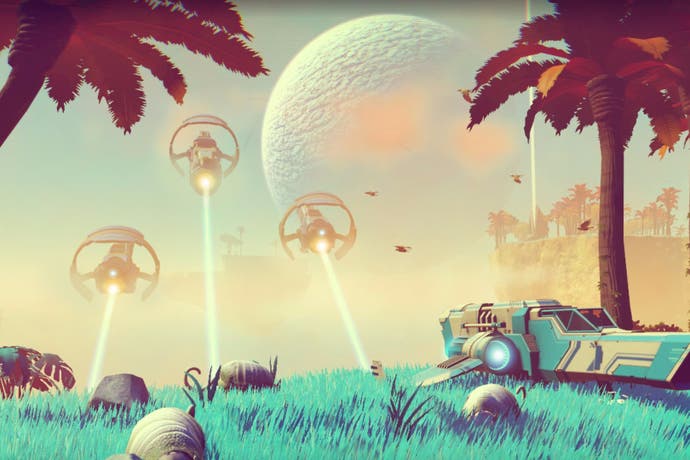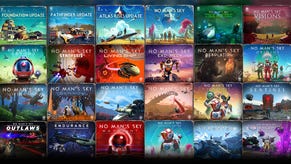The art of No Man's Sky
A brief look at the artwork that inspired Hello Games' space exploration epic.
Science fiction has always been at the core of No Man's Sky. That might seem like a superfluous thing to say, given its scope, its fantasy and its attempt to realise the awe-inspiring spectacle of a life lived amidst a near-infinite sea of stars, but it's a very particular brand of science fiction that the team at Hello Games (they're a small team, I think I've heard) have taken to heart.
"We wanted to make a science fiction game, and I don't feel that anyone has really made what I consider a real science fiction game," the project lead Sean Murray told us back when the game was first revealed well over a year ago, before elaborating on why there hasn't yet been a proper science fiction game.
"[There isn't] one that matches my view of what science fiction is. My view is what I grew up with, which is book covers - that's what I picture as science fiction. Often quite colourful, quite vibrant, quite exciting to look at. A mixture of all the authors you can think of, Heinlein, Clarke, Asimov, but also Chris Foss, the actual artist behind them. That's how I picture those worlds."
The possibility offered by No Man's Sky has been a large part of its appeal - as well as that enduring question of what you actually do in its vast universe - but another part of it is certainly its vision, one taken from the paperback covers from such imprints as Panther, Arrow and Ace.
At a GDC talk a couple of weeks back, Hello Games' artist Grant Duncan elaborated on some of the artists that inspired the look of No Man's Sky, and the works that have informed this soft, tangible and engrossing brand of sci-fi. Here's a selection of those artists, and what Duncan had to say about what they brought to No Man's Sky's aesthetic.
Chris Foss
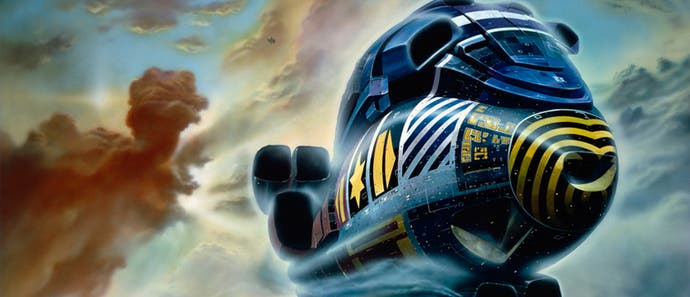
The influence of Foss on the world of sci-fi is hard to overstate. His cover art is as iconic as it gets, and he played a part in a classic of sci-fi cinema that has shaped our vision of the future: visionary director Alejandro Jodorowsky picked him for the film-maker's sadly unrealised vision of Dune, and much of that crew moved over to work on designing the look and feel of Ridley Scott's Alien. Foss' impact on games is just as immense.
"Anyone who's played Homeworld, you'll look at these ships and you'll realise they were inspired by the same kind of artwork that inspired me. What's great about Chris Foss is he started his career working on erotic artwork - he worked for Penthouse, he illustrated the Joy of Sex, and apparently his understanding of the female anatomy is what led to him creating such incredible designs.
"What I really love is that he created this kind of art when everyone else was creating black starfields, grey dull monolithic spacecrafts. And he created this and people loved it - I can't imagine somebody taking that kind of risk and just doing something so different to what everyone else is doing. I think that's why he's one of my favourite artists."
John Harris

Harris might not be as well-known a name as Foss, but he's just as prolific, his work having graced the covers of the likes of of sci-fi giants as Asimov, Pohl and Haldeman. A little closer to home, you might know him from his work in video games. Harris was responsible for the cover art on the manuals of the ZX81 and Spectrum back in the early 80s.
"He's a little bit different - he's quite formulaic, but that image, that could be Kenya? That could work, but then you've got this giant building. How big is that, it doesn't make any sense. Those people are so tiny, it doesn't even work. It's just the size of it, it's beautiful. It's the softness he gets with his brush strokes. Everyone else was using black in space. One of the things I've tried to keep away from in No Man's Sky is the colour black. Artists like Chris Foss, they use colours, there's none of this black."
Jean Giraud (Moebius)
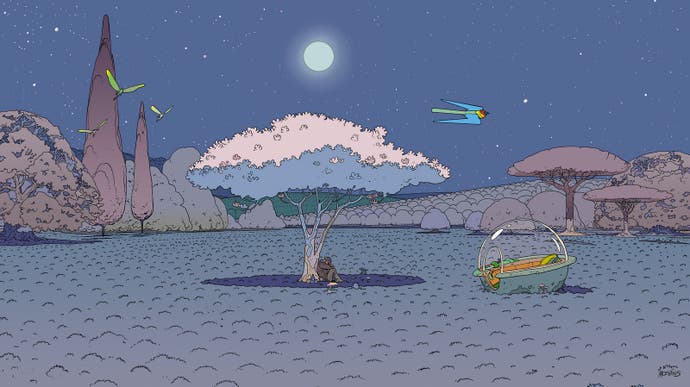
French artist Moebius, who sadly departed in 2012, left an indelible mark on the world of science fiction. His artwork was the result of an imagination unmatched, and his visions of the future were to prove an inspiration to the neon vision of 21st century Los Angeles that was the bedrock of Ridley Scott's Blade Runner.
"He walks that line between science fiction and fantasy. What I love about it is it's a place you want to be. So much science fiction, especially in games, they're these horrible post-apocalyptic warzones. Everyone's just trying to kill each other in different ways. Every game that's set in a science fiction universe seems to be like it's this amazing world and you can kill each other there.
"There's something about Moebius' work where nobody's killing each other. They probably could do if they want but they're not, and I find that kind of refreshing. It's just filled with questions, you want to know the history. You want to know what they're doing. You want to fly down, you want to understand those creatures are and what they're doing."
Ralph McQuarrie
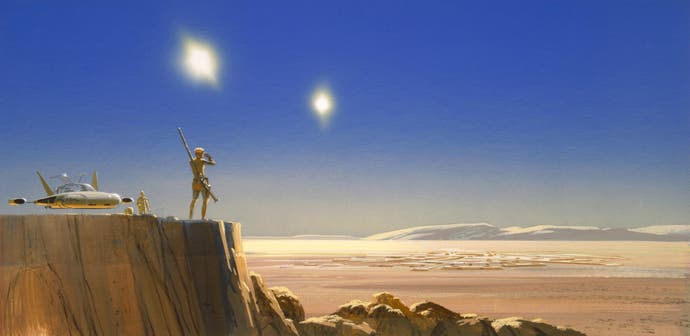
You'll know McQuarrie, of course, from his incredible body of work that takes in the original Star Wars trilogy as well as Raiders of the Lost Ark, E.T. The Extra-Terrestrial and - a personal favourite - Batteries Not Included.
"I almost didn't want to include Ralph, because it's almost too predictable, but you can't pretend that he wasn't a huge influence. His work on Star Wars, X-Wings and Tie Fighters. It's that thing that all great artwork has - especially art direction-wise - where everything fits together. It's coherent, and even though the ships and universe - they're different, and they're not like our universe, but you don't question it, you just accept it. He's got that same fantasy/sci-fi softness.
"To me, science fiction, it's not about war, it's about that feeling of the frontier, that feeling of adventure. It's not post-apocalyptic, it's exciting and it's full of hope. I always thought Star Trek, even though I've never been a massive fan, it had that - humanity had done okay, and managed to get to a place where we had wonderful technology. There were wars going on, but as a species we were doing well - it was a place you wanted to be in."
The real world
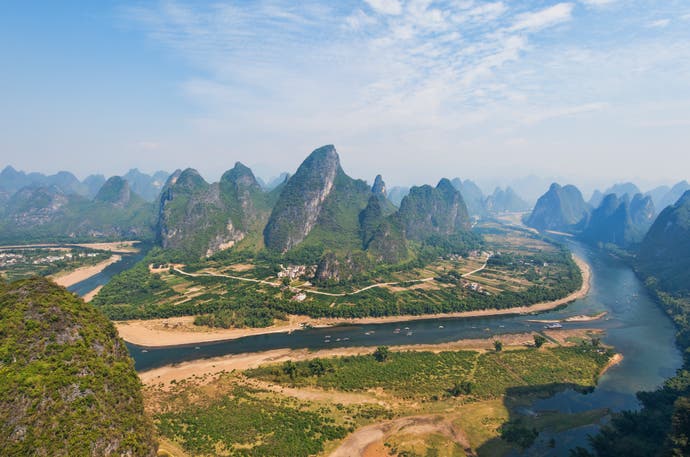
The rich world of sci-fi art was important to Hello Games as it nailed down the look of No Man's Sky, but often the best inspiration was to be found not by looking to the stars but by paying attention to what's a little closer to home. The beautiful landscapes of Guilin, the twisted ruins of Angkor Wat and the chocolate hills of the Philippines all proved inspirational.
"It's so tempting when you're working on a sci-fi world just to go straight in and make crazy alien landscapes and giant tentacle trees and things like that. What we tried to do was look at the real world and understand things like landscapes. It's why I wished I'd paid more attention in geography. I vaguely remembered all these terms like glaciers, limestone caves and coastal erosion. All these things I'm an expert in now. We're not simulating these things - doing that in real-time would be pretty crazy. What we try to do is get similar results. We have limestone caves, we have lava caves, we have wind erosion and coastal erosion, we have glacial erosion and volcanic islands - at least we have things that appear to be those kinds of things."
The cinema of Harryhausen
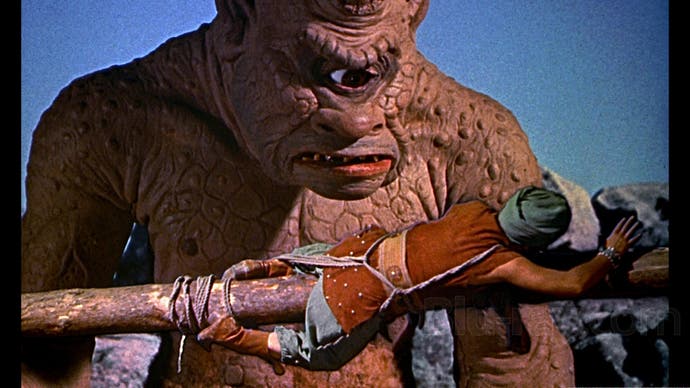
It's not just sci-fi that's shaped the art of No Man's Sky. The brand of cinema that's typical to the childhood of so many people who are now in their late twenties and early thirties - that typically stalked by creations of visual effects creator Ray Harryhausen - also played its part.
"Movies like Mysterious Island, Sinbad or the Odyssey - even though they're pioneers going to islands, there's a definite crossover with sci-fi, where rather than going to an island you're going to a whole new planet. Obviously they could be quite cheesy, with giant crabs, but, especially as a kid, they had this feeling that you arrived at this island and anything was possible."
The mesh of influences makes for a game with an alluring sense of sci-fi - and its appeal can perhaps be put down to how universal it is. "When we first announced No Man's Sky, it was incredible how many developers came up to us afterwards, and they were all saying this is the game I always wanted to be making, or I started working on a game like this," says Duncan. "We're not pretending that No Man's Sky is this idea that no-one's ever had. Everyone's had this idea, ever since we were children. You'd build a world and you'd populate it with your creatures and your characters - No Man's Sky is the ultimate art project for that. I can create a planet, I can do whatever I want - and it's absolutely terrifying."
Image credits: Chris Foss, John Harris, Jean Giraud and Ralph McQuarrie.
